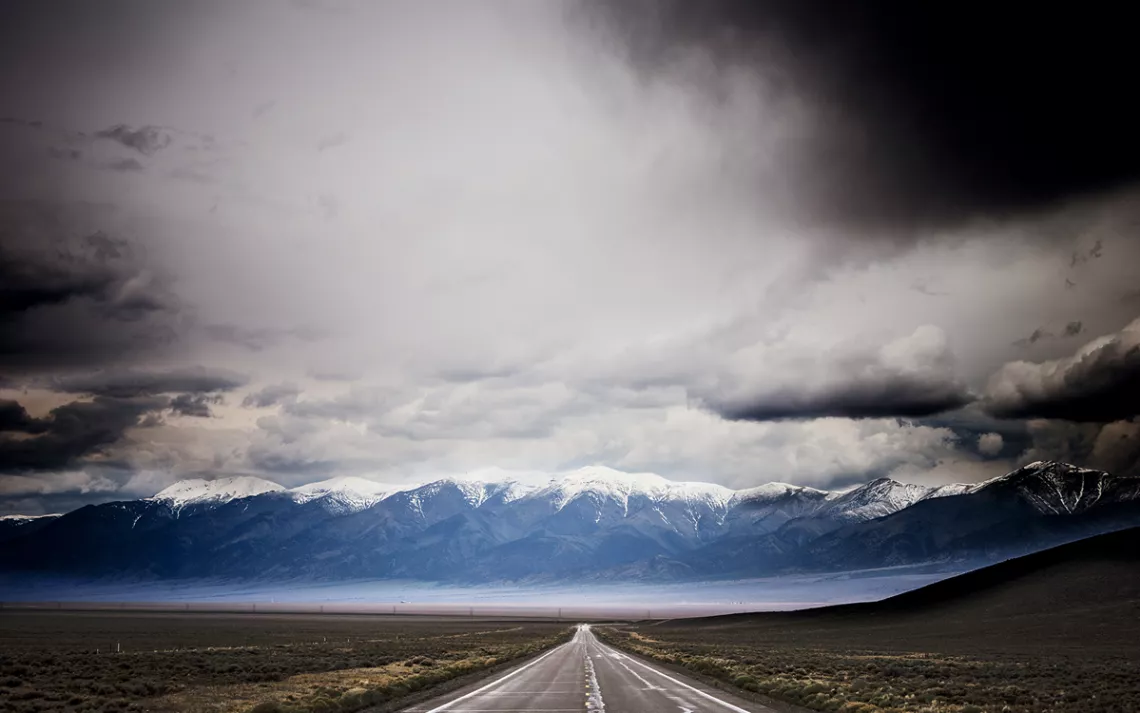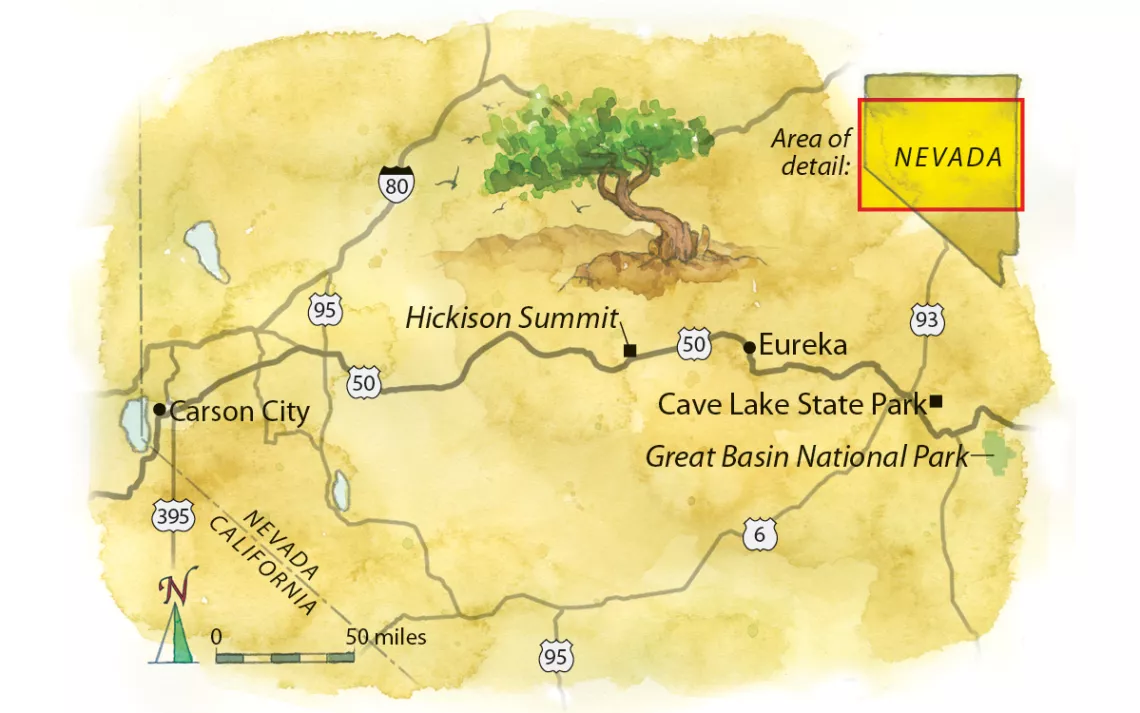A Cyclist Goes It Alone on Nevada's Highway 50
Biking America's loneliest road is an exercise in solitude

Over 30 years ago, Nevada's segment of Route 50 was dubbed the "Loneliest Road in America." The state took pride in the name. | Photo by Ron Koeberer/Tandem Stills + Motion
I stood with my bike on Hickison Summit, gazing at the windswept, sepia-tinted desert below. Dusty sagebrush lined the road stretching before me; snowcapped peaks rimmed the horizon. I had a reservation in a historic hotel in Eureka, Nevada, that evening and five hours of daylight to cover 46 miles. I pushed off and began coasting down the gentle grade.
In four days, the friend who had just dropped me off would meet me 190 miles to the east, in Great Basin National Park. Eight mountain ranges and two towns lay between me and my final destination. Summers frequently sizzle in the triple digits out here, and winter brings a deep, bitter freeze, but I was starting my trip in early spring and the weather was pleasantly cool.
When most Americans think of Nevada, they imagine the bright lights of the Las Vegas Strip–or maybe the Hoover Dam–with a desolate wasteland lying just beyond. Few know anything of the state's waves of colorful slickrock and ancient petroglyphs, its stark summits and alpine lakes. Even fewer get out of their cars to look when they drive through. And only a tiny handful traverse Nevada by bike.
My solo bike ride through the eastern part of the state combined some of the best elements of backpacking and bike touring: hundred-mile vistas of unpopulated wildlands, dazzling mountains, hours alone with my thoughts, and the smooth glide of asphalt beneath two thin, hard tires. Over 30 years ago, Life magazine called the 400 miles of US Route 50 that cross Nevada the "Loneliest Road in America," and the state adopted the term with pride. I'd driven this route twice before, hypnotized by the rhythmic rise and fall of mountains swelling from the sea of sagebrush. But I didn't understand the solitude and magnitude of the Great Basin Desert until I was powering myself through it. Such vastness can't be properly appreciated at 75 miles per hour.
Bisecting the nation's largest and highest desert, Highway 50's two lanes reveal Nevada's bones: sprawling mining projects, open rangeland, and sparse forest. This is Pony Express country, with broad plateaus punctuated by north-south-trending mountains. Isolated ranges, some with peaks of 13,000 feet, rise like islands from the desert, dotted with junipers, piñons, and bristlecone pines. The floor of the basin is rarely below 4,000 feet.
A gentle tailwind brought me down the short descent off Hickison Summit into a broad, flat valley. Pedaling hard along the straight road put me in a Zen-like stupor–which I was jolted out of by the thousand-foot climb up to the next pass. The road wound amid sheer canyon walls and broken rock faces, curving and dipping like a roller coaster before dropping down into another broad valley. The next range shimmered on the horizon, 20 miles distant.
I've ski toured solo and backpacked many remote Sierra Nevada peaks without seeing another human for days, and I found a warm, wild joy in that. But biking through this barely inhabited and austere desert accompanied by only constant wind and overpowering silence left me with a dull ache in my chest and a yearning I could not banish.
Halfway through my second day, the clatter of hooves on pavement shattered the stillness—a herd of cattle crossing the road, guided by three equestrians: a mother, a father, and their four-year-old son, each riding bareback. The parents were third-generation ranchers in the area and the first people I'd spoken to since leaving Eureka that morning.

Map by Steve Stankiewicz
A cyclist can stake claim to the full lane out here. Every half hour or so, the rumble of an engine intruded on the silence, slowly gaining volume until the vehicle passed quickly in the opposite lane, leaving me alone again under the open sky.
That night, I camped at Cave Lake State Park. The next morning, I found cellphone reception on a windswept knoll half a dozen miles down the road from the park. I called my mother and tried to explain the sage and the summits, the mesmerizing undulation of basin and range, the wistful longing I felt when I contemplated my own insignificance amid such vastness. But whatever I was experiencing could only be savored or suffered alone; it couldn't be shared.
Even on my fourth and final day of biking, when I passed through the town of Ely–where the road widens to four lanes and is lined with casinos and motels–I couldn't shake that nameless yearning. But by then, something in me had shifted. I had come to almost enjoy the unfamiliar sensation, to examine it with curiosity.
We live on a noisy, urbanized, and industrialized planet. Some of our most beloved national parks have become recreational playgrounds, filled with jostling crowds. The basin-and-range topography of eastern Nevada provides a healthy dose of the immense, untrammeled spaces that may be our most precious commodity. Traversing it by bike taught me to appreciate the unique solitude it offers.
Take a Sierra Club trip to Nevada. For details, see sierraclub.org/adventure-travel.
This article appeared in the May/June 2019 edition with the headline "Alone on the Loneliest Road."
- WHERE US Route 50, Nevada
- GETTING THERE The highway stretches over 3,000 miles from West Sacramento, California, to Ocean City, Maryland. The Nevada section crosses 17 mountain passes along its 408-mile journey from the California border near Lake Tahoe to the Utah border near Great Basin National Park. You'll need to arrange your own transportation to access this section of Route 50 by bike.
- WHEN TO VISIT Route 50 passes through a wide elevation range, and the weather varies accordingly. Spring and fall offer the most comfortable weather, though nights can dip below freezing.
- WHERE TO STAY There are five campgrounds and RV parks where you can pitch a tent between Austin, Nevada, and the Utah border. Eureka, Austin, and Ely have a range of lodging options.
- FURTHER READING Wild Nevada: Testimonies on Behalf of the Desert (University of Nevada Press, 2005) contains 30 essays and poems that aim to inspire conservation of this wild, sparsely populated state. Shoshone elders, US senators, Gary Snyder, Terry Tempest Williams, Dave Foreman, and many others contributed.
 The Magazine of The Sierra Club
The Magazine of The Sierra Club



